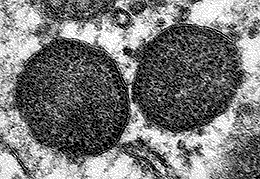What can be expected of a multifactorial disease from an etiological point of view? Without a doubt, at the beginning we have confusion. For some diseases it seems that we are changing the terminology from “causal agent of” to “essential agent of”. In fact, the first term is indisputable within the frame of the so-called “unifactorial diseases”, but the reality is that these are actually very few in number among the current porcine pathology and the majority of them are found noticeably modulated or boosted by a series of distinct infectious or non-infectious factors to the presumed causal agent. This is the situation of PMWS.
 |
| Figure 1. Electronic microphotograph of two cytoplasmic inclusion bodies of a macrophage, which include a very high number of porcine circovirus type 2 particles. Original enlargement: 150,000x (Photograph by Carolina Rodríguez-Cariño). |
Porcine circovirus type 2 is a viral agent with a diameter of 17 nm, one of the smallest of all animal viruses. (Fig. 1). It presents a relatively simple structural organization: a virus without envelope, with a capside formed mainly by one protein (protein Cap or product of the fragment of open reading frame 2 [ORF 2], and a simple chain of DNA of approximately 1767-68 nucleotides. This genome also encodes by proteins involved in the viral replication (Rep and Rep’, products of ORF1). An ORF3 would exist that according to speculation could encode a protein with apoptotic capacity; however, the function of this protein is not currently clear. It is a highly resistant virus which by definition is difficult to eliminate with disinfectants. Chlorhexidine, formaldehydes, iodine and bleach are considered to be useful for diminishing the viral load in vitro.
From the philogenetic point of view two large groups of PCV2 are considered. These groups have recently been defined as two distinct genotypes (1 and 2), and genotype 2 is considered to be older from an evolutionary point of view (Fig 2). From this classification, it is logical to wonder whether or not all the PCV2 genotypes present the same virulence. The answer to this question is not clear. If we consider it as “a success” that from an experimental infection with PCV2 at least one animal became ill with PMWS, one can conclude that both genotypes are pathogens. However, this pathogenicity is brought about by trigger factors for both genotypes. If we measure this “success” as the proportion of experiments which achieve at least one infected pig, then we realise that the percentage is greater with genotype 1. So, is genotype 1 more virulent than genotype 2? The answer is not easy, but there are currently indications that this could be so:

- The cases of epizootic appearance in North America have been associated with a very marked increase in the prevalence of PCV2 strains of genotype 1.
- A recent study carried out in Europe systematically associates genotype 1 with the existence of disease, while this is not always the case with genotype 2.
_32149.gif) |
| Fig. 2. Phylogenentic tree. |
If these facts could explain the appearance of epizootic outbreaks of PMWS at the end of the 90s in Europe and North and South America, it is something that has not been demonstrated. One possible hypothesis is that PCV2 genotype 2, which is potentially less virulent, has been the most frequent genotype for a long time, with sporadic cases of disease (at least since 1986); the sudden appearance of a more pathogenic genotype, presumably the genotype 1, could have been responsible for the previously mentioned epizootic outbreaks of the disease. Let’s hope that the validity or not of this hypothesis can be resolved in the near future. It should however be pointed out that even within the same genotype there can exist pathogenic differences as was recently demonstrated in an experimental infection. On the other hand, and despite the existence of antigenic differences between distinct isolations of PCV2, the efficiency of the vaccines, regardless of the challenging genotype, suggests that although two genotypes exist, there may only be one serotype of PCV2.
However, since nearly ten years ago there has been another hypothesis to explain the sudden appearance of PMWS on a worldwide level: “agent X”. This would be an agent that would act in a way to facilitate an over-replication of PCV2, and so it would play a role as a trigger factor of the disease in 100% of cases. This hypothesis has been supported in the controversy of: how can a ubiquitous virus be the cause of a disease? Logically, this hypothesis comes before the possible sudden appearance of PCV2 genotypes with distinct virulence. What is certain is that after these ten years nobody has been able to isolate or detect this possible “agent X”, and the data from “successful” experimental infections would explain in a very difficult manner the existence of an “agent X”. If this “agent X” were responsible for triggering some cases of the disease, it would behave in a similar manner to porcine parvovirus and Mycoplasma hyopneumoniae (which trigger the disease in pigs co-infected with PCV2). In all these cases there has never been an agent, whose existence is unknown, that has generated so many comments!. It should be said, nevertheless, that despite the high efficiency demonstrated by vaccines against PCV2, this does not rule out the existence of the famous “agent X”.




